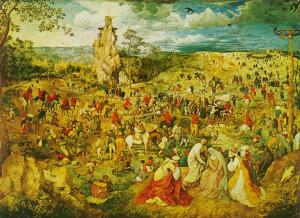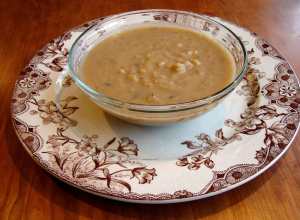2. The Seed Cutters
They seem hundreds of years away. Brueghel,
You’ll know them if I can get them true.
They kneel under the hedge in a half-circle
Behind a windbreak wind is breaking through.
They are the seed cutters. The tuck and frill
Of leaf-sprout is on the seed potates
Buried under that straw. With time to kill,
They are taking their time. Each sharp knife goes
Lazily halving each root that falls apart
In the palm of the hand: a milky gleam,
And, at the centre, a dark watermark.
Oh, calendar customs! Under the broom
Yellowing over them, compose the frieze
With all of us there, our anonymities.
Beautiful! And it got me to thinking about Brueghel, and about the fact that poets love him. We’ve talked about his Landscape with the Fall of Icarus, and the fact that WH Auden and William Carlos Williams both wrote poems about the painting. And William Carlos Williams, patron poet of The Ordinary, has a whole collection of poems called Pictures from Brueghel. Why do the poets love him so much? Is it because he tells stories with his paintings? He shows so many characters, so much movement and beauty and drama, but the drama of everyday life that we can all relate to. Is this why the poets of The Ordinary love him? Because he renders with such skill and accuracy some universal truth of humanity that we can all understand – with so much beauty and so few words. They called him “the peasant Brueghel,” apparently, in his day. Not because he was a peasant, but because he painted peasants, and some say he dressed as a peasant so he could mingle with them – unnoticed but noticing everything. This was very rare, at the time, and it is only through his paintings that we understand as much as we do about the lives of poor people in his place and in his time. I wonder why he painted peasants. Was it patronizing? Was it, as Van Gogh has said about The Potato Eaters, to show how less-civilized people lived? Was it opportunistic? Was it because these were the people who were everywhere about him, who would model for him. Because peasants must have served as models for paintings of nobility, as well, and for paintings of Christ and Mary. We’ll never know! The peasants in Brueghel’s paintings are so richly painted that it feels to me as if he’s honoring them. Seeing what I want to see, no doubt, through the lenses of my 21st century Ordinary agenda, it feels as though Brueghel captures some timeless quality that connects us all. We’re all engaged in the struggle and the joy of living, of staying alive, and working and resting and dancing. Heaney’s seed cutters might “seem hundreds of years away,” because they’re closely connected to Brueghel’s resting corn harvesters, and they’re connected as well to people taking a break outside of their offices or shops, sitting in the sun, eating a sandwich. Williams, in describing Brueghel’s nativity, says,
-
—it is a scene, authentic
enough, to be witnessed frequently
among the poor (I salute
the man Brueghel who painted
what he saw—
many times no doubt
among his own kids but not of course
in this setting)
Brueghel and Williams are reminding us that Mary and Joseph were poor, and that this was just a moment in time to the people milling about – the soldiers, who couldn’t have understood why this moment would be significant.
-
—the soldiers’ ragged clothes,
mouths open,
their knees and feet
broken from thirty years of
war, hard campaigns, their mouths
watering for the feast which
had been provided
Peter Brueghel the artist saw it
from the two sides: the
imagination must be served—
and he served
dispassionately.

We saw a beautiful film about Brueghel’s painting The Procession to Calvary, called The Mill and the Cross. It’s a gorgeous dream-like film, that fleshes out Brueghel’s characters in a mysteriously effective manner. It shows Brueghel creating the painting, and it connects the story of Christ to the suffering of Brueghel’s contemporaries at the hands of Spanish catholics. In the film, Brueghel explains that most paintings show God in the sky, parting the clouds and looking down with displeasure. But in his painting God is in a mill high on a strange mountain. God is a miller, grinding the bread of life and destiny. The bread that we all eat to nourish ourselves – soldiers and peasants and artists and Christ himself. We’re all connected by the struggle to stay alive.
Last night for dinner we ate this delicious soup and ate leftover mushroom pie and talked about Brueghel. It was a simple meal, but it was such a good conversation. I feel so lucky to have somebody with whom to puzzle these things out, and somebody who is comfortable, as I am, with not having answers. We’ll never know! This soup was good. I grated and roasted the rutabaga with some thyme (it smelled amazing cooking!) and then I added shallots, garlic, rosemary and some lentil-cooking water. I added sweet corn, for a touch of brightness, and melted in some sharp cheddar, which made the soup lovely and savory and satisfying. I puréed part, but left some as it was, because the grated rutabaga had such a nice texture.
Here is Alec Ounsworth with That is Not My Home (After Brueghel)
1 rutabaga
2 T olive oil
1 t thyme
2 T olive oil
1 shallot, minced
2 cloves garlic, minced
2 t rosemary, chopped
1/3 cup white wine
1 t mustard powder
1 cup corn kernels (I used frozen white corn)
4 cups vegetable broth or water
1 t balsamic vinegar
1 T butter
salt and plenty of freshly ground pepper
1 cup grated sharp cheddar
Preheat the oven to 425. Peel the rutabaga, and send it through the food processor to grate it. (or grate it by hand) Combine the grated rutabaga with the olive oil and thyme, and spread in an even layer on a baking sheet. Roast for about 30 – 35 minutes, till it is tender and it’s starting to brown and caramelize. Stir frequently because the pieces on the edge will brown first.
Warm the 2 T olive oil in a large soup pot over medium heat. Add the shallots and cook for about a minute, then add the garlic and the rosemary, and cook for about a minute more. When everything is starting to brown, add the wine. Cook for a few minutes until the wine is reduced and syrupy.
Add the rutabaga and the corn. Stir and cook till warm and coated with wine/shallot/garlic mixture. Add the mustard powder and about 4 cups of water or broth. You want enough to cover everything by about an inch.
Bring to a boil, reduce heat and simmer for 15 to 20 minutes, until the rutabaga is nice and soft. Add the butter, balsamic and salt and pepper. In a blender or food processor, puree about 1/2 the soup. This way it will be creamy, but still have a nice texture.
Return to the pot. Stir in the cheese. Warm through until the cheese has melted, and taste for salt and pepper. Serve!

